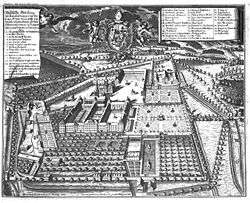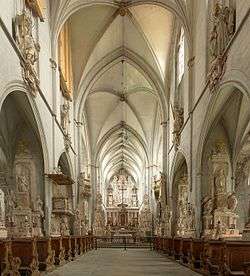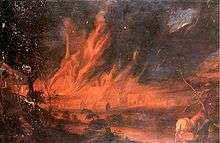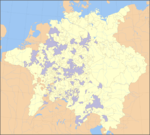Salem Abbey
| Imperial Abbey of Salem | ||||||||||
| Reichskloster Salem | ||||||||||
| Imperial Abbey of the Holy Roman Empire | ||||||||||
| ||||||||||
|
| ||||||||||
| Capital | Salem | |||||||||
| Government | Theocracy | |||||||||
| Historical era | Middle Ages | |||||||||
| • | Abbey founded | 1136 | ||||||||
| • | Gained Reichsfreiheit | the 12th century | ||||||||
| • | Secularised to Baden | 1803 | ||||||||
| ||||||||||



Salem Abbey (Kloster or Reichskloster Salem), also known as Salmansweiler and in Latin as Salomonis Villa, was a very prominent Cistercian monastery in Salem in the district of Bodensee about ten miles from Konstanz, Baden-Württemberg, Germany. The buildings are now owned by the State of Baden-Württemberg and are open for tours as the Salem Monastery and Palace.
Abbey
The abbey was founded in 1136 by Gunthram of Adelsreute (d. 1138) as a daughter house of Lützel Abbey in Alsace, in the foundation of which Gunthram had also been involved. Lützel was a daughter house of Bellevaux Abbey, in its turn the first daughter house of Morimond. Blessed Frowin of Bellevaux, formerly the travelling companion and interpreter of Bernard of Clairvaux, became the first abbot of Salem. He had been professed at Bellevaux, and was of the colony sent to found Lützel, and this has caused some misunderstandings in the past to the effect that Salem was founded from Bellevaux rather than from Lützel.
The abbey soon became very prosperous. Extensive and magnificent buildings, erected in three squares, and a splendid church were constructed between 1182 and 1311. Salem was noted as the richest and most beautiful monastery in Germany, being particularly renowned for its hospitality. Amongst its greatest benefactors and patrons were Conrad of Swabia and Frederick Barbarossa. The former placed the abbey under the special protection of himself and his successors, whence the title of "Imperial abbey" ("Reichsabtei" or "Reichskloster" — independent from all territorial lordship bar that of the emperor alone) which was renewed several times under Barbarossa and his successors. Pope Innocent II also took the abbey under his particular patronage.
Its growth was continuous; after having made three important foundations — Raitenhauslach Abbey (1143), Wettingen Abbey or Stella Maris (1227), and Königsbronn Abbey (1303) — it still numbered 285 monks at the beginning of the 14th century. Its abbot, from 1454 on, was privileged to confer subdeaconship on his monks.

The abbey gradually declined, and with the exception of the church was almost entirely destroyed by a fire in 1697. Rebuilding started immediately and Salem was reconstructed as an impressive Baroque complex.
Later in the century the abbey undertook between 1746 and 1749 the development of the pilgrimage church of Birnau under the supervision of Peter Thumb.
Caspar Oexle, who, as librarian, had increased the library to 30,000 volumes and a great number of manuscripts, was elected abbot in March 1802. In September of the same year the abbey was suppressed and given to the Margrave of Baden, while the library was added to that of Petershausen Abbey, and finally sold to the University of Heidelberg.
The church, known as Salem Minster ("Salemer Münster"), a Gothic structure which escaped the fire of 1697, became a parish church; but the famous grand tower with its fifteen bells, the largest weighing 10,000 lb, was destroyed in 1805–07.
Secularization
Following the Reichsdeputationshauptschluss 1803 and the nearly complete secularization in Germany the history of the monastery ended and the monks left the abbey.
Castle
The other abbey buildings were used as the castle of the Grand Dukes of Baden, and the site was from then on known as Schloss Salem.
School
In 1920, part of the castle premises were acquired for use as a boarding school, which continues to this day as the Schule Schloss Salem.
References
-
 This article incorporates text from a publication now in the public domain: Herbermann, Charles, ed. (1913). "Salem". Catholic Encyclopedia. New York: Robert Appleton.
This article incorporates text from a publication now in the public domain: Herbermann, Charles, ed. (1913). "Salem". Catholic Encyclopedia. New York: Robert Appleton.
External links
| Wikimedia Commons has media related to Monastery of Salem. |
- Salem Monastery and Palace - official site
- School Schloss Salem website
- Salem overview
- Salem history
Coordinates: 47°46′34″N 9°16′46″E / 47.77611°N 9.27944°E


